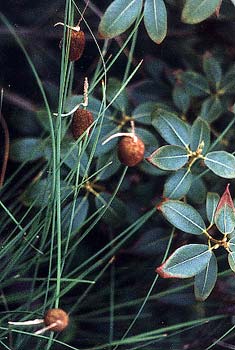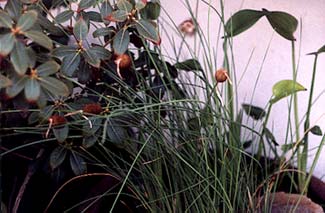
Dwarf Cattails,
A Bog-Garden Charmer
Typha minima closely resembles the large wild cattails you see in boggy areas alongside roads, but is only about two feet tall. Its leaves are sedge-like, with two-inch round brown catkins on stems about as tall as the grass. I constructed a very small waterfall out of two big round pots, & planted the miniature cattails in the upper pot. Planted close around the pots are numerous other plants, including Lily Turf Liriope muscari & (with one lower branch visible in the cattail portrait) Rhododendron concinnum.
A month or so after the present portrait was taken, a mean ol' racoon ripped the bog garden to bits. I repaired it as best I could, then the racoon came back & ripped it up worse than the first time. This recurred a half-dozen times, but at some point the critter couldn't make things any worse. I always try to orchestrate the garden in such a manner that visits of that type won't result in much damage, as gardening is supposed to reflect a love of nature, not induce an abhorence for the real thing as when nature-phobic gardeners begin to regard squirrels, moles, racoons, skunks, & birds their worst enemies.
So I stripped down the number of plants inside the bog area's primary forest-bowl which invited the racoon to splash & play. Next year the dwarf cattails will be the primary plant, & the other bog plants have already been transferred to large sunken paintbuckets or other areas that provide the bog environment outside the enticing pool. The pool is now mostly free of plants & the racoon still visits & sometimes unhooks the pump, but cannot otherwise cause harm.
All cattails are edible. In early spring when new shoots appear, these are tender delicacies. A bit later in late May or early Spring when the catkin are forming, the kittens themselves are edible & rather like baby corncobs. When they go brown & produce pollen, the pollen can be shaken out of the flowers in copious amounts, to mix with flour for baking. When it goes to fluffy seeds, this has been used for pillow stuffing.
 It is the rare garden that has a bog area for enough cattails to harvest to eat, & Dwarf Cattail in particular is only going to be grown for its decorative value. But the garden's cattails can be used as "timing reminders" to go harvesting in the wild. In that brief time when the catkins are tasty & tender as baby corncobs, you'll see them ready in the garden, & take that as an announcement to put on waders & visit swamps or run-off areas to get the larger cobs from wild T. latifolia (here on the west coast) or T. angustifolia (if you're on the east coast).
It is the rare garden that has a bog area for enough cattails to harvest to eat, & Dwarf Cattail in particular is only going to be grown for its decorative value. But the garden's cattails can be used as "timing reminders" to go harvesting in the wild. In that brief time when the catkins are tasty & tender as baby corncobs, you'll see them ready in the garden, & take that as an announcement to put on waders & visit swamps or run-off areas to get the larger cobs from wild T. latifolia (here on the west coast) or T. angustifolia (if you're on the east coast).They are in full brown flower in June, when it's far too late to eat them, & when they are at the height of their decorative power. The brown blooms last well into July, but by the end of the month have turned into a fluff-balls of seeds that scatters on the wind. Unless you live on the edge of a swampy area there is only the smallest chance of them self-seeding anywhere.